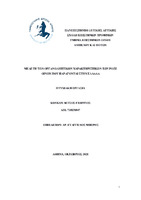| dc.contributor.advisor | Μπερής, Ευάγγελος | |
| dc.contributor.author | Κουκουλέτσος, Γεώργιος | |
| dc.date.accessioned | 2022-01-10T08:15:31Z | |
| dc.date.available | 2022-01-10T08:15:31Z | |
| dc.date.issued | 2021-09 | |
| dc.identifier.uri | https://polynoe.lib.uniwa.gr/xmlui/handle/11400/1638 | |
| dc.identifier.uri | http://dx.doi.org/10.26265/polynoe-1489 | |
| dc.description.abstract | Η αντίληψη της γεύσης και του αρώματος του οίνου είναι το αποτέλεσμα πλήθους
αλληλεπιδράσεων μεταξύ ενός μεγάλου αριθμού χημικών ενώσεων και
οργανοληπτικών υποδοχέων. Οι ενώσεις αλληλεπιδρούν και συνδυάζονται και
εμφανίζουν συνεργιστικές και ανταγωνιστικές αλληλεπιδράσεις. Το χημικό προφίλ
ενός οίνου προέρχεται από το σταφύλι, τη μικροχλωρίδα της ζύμωσης (κυρίως από
την ζύμη Saccharomyces cerevisiae), τις δευτερογενείς μικροβιακές ζυμώσεις και
διεργασίες που μπορεί να συμβούν και την ωρίμανση και αποθήκευση του οίνου. Η
σύσταση των σταφυλιών εξαρτάται από το γονότυπο της αμπέλου και από την
αλληλεπίδραση του γονότυπου και του φαινοτύπου με πολλούς περιβαλλοντικούς
παράγοντες. Η μικροχλωρίδα, και ιδίως ο ζυμομύκητας που είναι υπεύθυνος για τη
ζύμωση, συμβάλλει στο άρωμα του οίνου με διάφορους μηχανισμούς: πρώτον με τη
χρήση συστατικών του χυμού των σταφυλιών και τη βιομετατροπή τους σε συστατικά
που επηρεάζουν το άρωμα ή τη γεύση, δεύτερον παράγοντας ένζυμα που
μετατρέπουν τις ουδέτερες ενώσεις των σταφυλιών σε αρωματικές ενώσεις και,
τέλος, με την επιπλέον σύνθεση πολλών ενεργών αρωματικών πρωτογενών ενώσεων
(π.χ. αιθανόλη, γλυκερόλη, οξικό οξύ και ακεταλδεΰδη) και δευτερογενών
μεταβολιτών (π.χ. εστέρες, αλκοόλες, λιπαρά οξέα). Σκοπός της παρούσας εργασίας
είναι η παρουσίαση μιας επισκόπησης σχετικά με το σχηματισμό των αρωματικών
ενώσεων του οίνου, συμπεριλαμβανομένων των προδρόμων μορίων που υπάρχουν
στα σταφύλια και των χημικών ενώσεων που παράγονται κατά την αλκοολική
ζύμωση και σχετίζονται άμεσα με την παραγωγή αιθανόλης ή δευτερογενών
μεταβολιτών καθώς και πως αυτά αντιλαμβάνονται κατά την οργανοληπτική
αξιολόγηση του οίνου. Παρουσιάζεται η συμβολή της μηλικογαλακτικής ζύμωσης
και της ωρίμανσης στο άρωμα και τη γεύση του οίνου. Επίσης, περιγράφονται οι
μέθοδοι προσδιορισμού των αρωματικών συστατικών του οίνου είτε με χημικές
αναλύσεις είτε με οργανοληπτική αξιολόγηση με στόχο τη συσχέτιση της χημικής
σύστασης με τις μοναδικές οργανοληπτικές ιδιότητες για τις διαφορετικές ποικιλίες
οίνων. | el |
| dc.format.extent | 97 | el |
| dc.language.iso | el | el |
| dc.publisher | Πανεπιστήμιο Δυτικής Αττικής | el |
| dc.rights | Αναφορά Δημιουργού - Μη Εμπορική Χρήση - Παρόμοια Διανομή 4.0 Διεθνές | * |
| dc.rights | Attribution-NonCommercial-NoDerivatives 4.0 Διεθνές | * |
| dc.rights.uri | http://creativecommons.org/licenses/by-nc-nd/4.0/ | * |
| dc.subject | Ροζέ οίνος | el |
| dc.subject | Αρωματικά συστατικά | el |
| dc.subject | Οργανοληπτική αξιολόγηση | el |
| dc.title | Μελέτη των οργανολητικών χαρακτηριστικών των ροζέ οίνων που παράγονται στην Ελλάδα | el |
| dc.title.alternative | Sensory evaluation of Greek rose wines | el |
| dc.type | Πτυχιακή εργασία | el |
| dc.contributor.committee | Κεχαγιά, Δέσποινα | |
| dc.contributor.committee | Ευαγγέλου, Αλεξάνδρα | |
| dc.contributor.faculty | Σχολή Επιστημών Τροφίμων | el |
| dc.contributor.department | Τμήμα Επιστημών Οίνου, Αμπέλου και Ποτών | el |
| dc.description.abstracttranslated | The perception of the taste and aroma of wine is the result of a number of interactions
between a large number of chemical compounds and organoleptic receptors. The
aromatic compounds interact and combine to exhibit synergistic and competitive
interactions. The chemical profile of a wine is affected by the grapes variety, the
fermentation microflora (especially the Saccharomyces cerevisiae), the secondary
microbial fermentations that can occur as well as the ripening and storage conditions.
The chemical composition of the grapes depends on the genotype of the vine and on
the interaction of its genotype and its phenotype with many environmental factors.
The microflora, and in particular the yeast responsible for fermentation, contributes to
the aromatic compounds of the wine by various mechanisms: firstly by using grape
juice ingredients and converting them into ingredients that affect the aroma or taste,
secondly by producing enzymes that convert neutral compounds in aromatic
compounds and, finally, by the composition of many active aromatic primary
products (eg ethanol, glycerol, acetic acid and acetaldehyde) and secondary
metabolites (eg esters, alcohols, alcohols, fatty acids). The aim of this paper is to
present an overview of the formation of aromatic compounds in wine, including the
precursors of molecules present in grapes and chemical compounds produced during
alcoholic fermentation and directly related to the production of ethanol or secondary
metabolites and also who all these aromas affect the organoleptic characteristics. The
contribution of malolactic fermentation and maturation to the aroma and taste of the
wine are presented. Also, the determination methods of the aromatic components of
the wine are described either by chemical analysis or by organoleptic evaluation in
order to correlate the chemical composition with the unique organoleptic properties
for the different wine varieties. | el |



